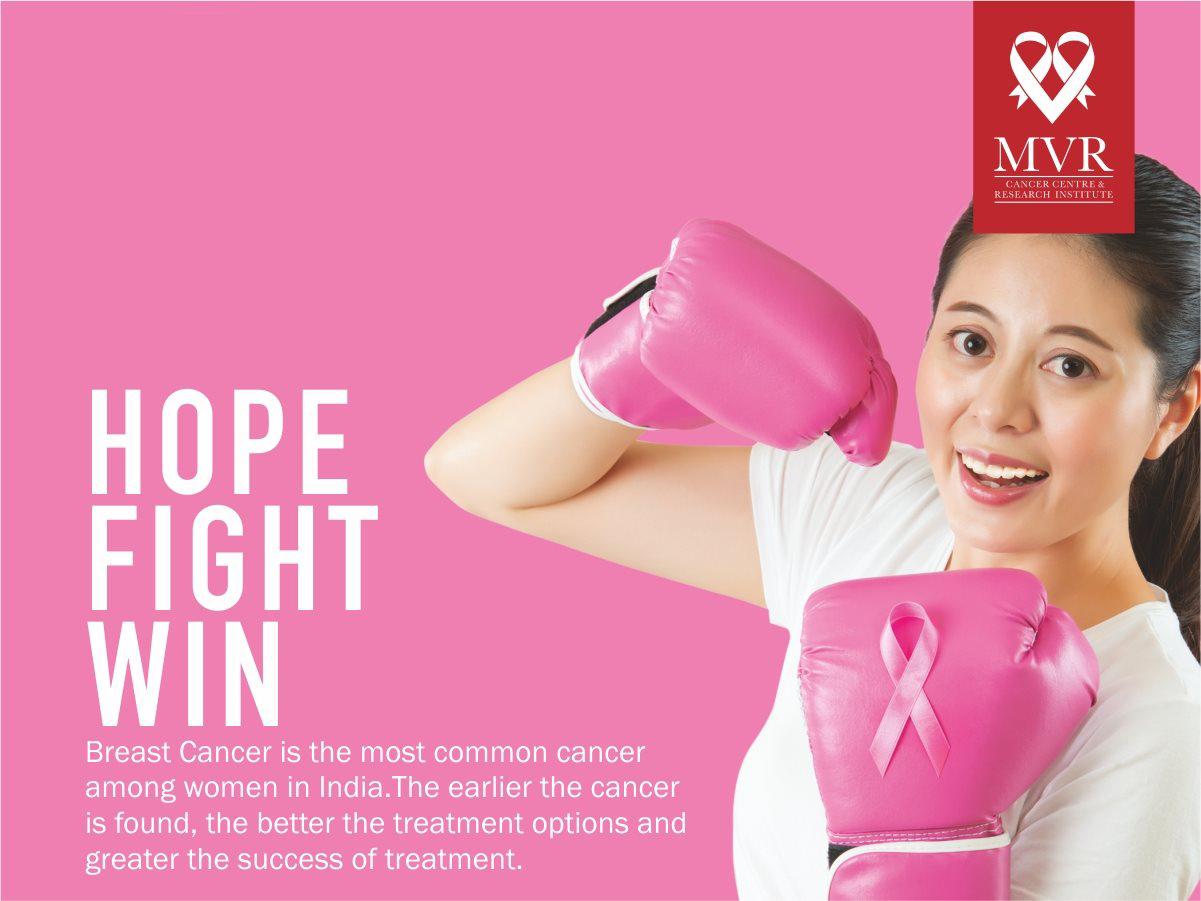BREAST CLINIC

Introduction
Women of all ages are being increasingly affected by breast disorders including breast cancer. Breast cancer accounts for 16% of all female cancers and is the most common invasive cancer in women worldwide. To combat this grave situation, MVRCCRI has set up a Speciality Breast Clinic that focuses on educating women on the benefits of preventive screening and self-examination of breasts.
What are Breast Disorders?
Breast disorders may be benign (non-cancerous) or malignant (cancerous). Most breast disorders such as breast pain or tenderness, breast lumps, inverted nipples, nipple discharge or changes to the skin of the breast are benign. Breast diseases could affect women of all ages, right from adolescents to older women.
Breast cancer occurs when cells in the breast begin to overgrow. These cells form a tumour that can be detected by an x-ray or even felt as a lump. The tumour is cancerous if the cells grow into surrounding tissues or spread to distant areas of the body. Breast cancer affects women almost entirely, but there is a chance that men can get it too.
What causes Breast Disorders?
Some common causes of breast disorders are:
✦ Changes in the hormones during the menstrual cycle
✦ A collection of calcium deposits
✦ Skin injury, muscle or connective tissue strain, spinal conditions or an underlying condition such as chest pain or heartburn
✦ An underactive thyroid, an increase in the prolactin hormone or side effect of some medication
✦ Abnormal growth within the breast
Causes of breast cancer include
✦ Ageing
✦ Genetics
✦ A history of breast lumps or breast cancer
✦ Dense breast tissue
✦ Oestrogen exposure
✦ Obesity
✦ Taller than average height
✦ Alcohol consumption
✦ Radiation exposure
✦ Hormone replacement therapy
What are the symptoms of Breast Disorders?
Breast pain or tenderness – Cyclical breast pain (pain that comes and goes with the menstrual cycle) is common. If the pain is non cyclical, your doctor will conduct a breast examination to determine the cause and suggest treatments such as pain relief medication, decreasing the dose or discontinuing medicines containing oestrogen, suggesting a bra with better fitting or even prescribing dietary changes.
Breast lump – A breast lump can be identified by looking or feeling your breasts. For women below the age of 30, a breast lump may appear just before their period and resolve once the period is over. However, if the lump persists, you may be asked to go for a breast ultrasound or needle aspiration biopsy. For women over the age of 30, a diagnostic mammogram and an ultrasound and even a breast biopsy may be prescribed.
Inverted nipples – Women born with nipples that naturally invert and evert and women who experience nipple inversion while breastfeeding have no cause for concern. However, if your nipples have always been everted and suddenly begin to invert, a breast examination and mammogram may have to be conducted to assess the reason for the same.
Nipple discharge – Milky-coloured discharge from both nipples during the first year of birth is common. Besides this, a small quantity of physiologic discharge (yellowish, greenish or brownish discharge that is squeezed out) is also not a cause for concern. However, in case of spontaneous nipple discharge or discharge that is clear or bloody; a mammogram, an ultrasound and/or a ductogram (examination of the breast ducts) will be prescribed to diagnose the cause.
Changes to the breast skin – Skin problems such as moles, cysts, rashes or skin infections could cause itching, scaling, swelling, redness or change in skin colour on or near the breast skin. However, if they do not settle within a few days, further investigative tests may be recommended. Breast skin evaluation involves a breast examination, a mammogram and sometimes even a skin biopsy.
Breast Cancer – One of the most common symptoms of breast cancer is a new lump or mass. A hard, painless mass with irregular edges is more likely to be cancerous. However, a soft, tender, rounded or painful lump could also be a breast cancer. Swollen lymph nodes are also a symptom to watch out for. Symptoms of other breast disorders such as swelling, changes in the breast skin, breast or nipple pain, inverted nipples and nipple discharge could also indicate breast cancer.
How can we help?
We at MVRCCRI Breast Clinic constantly emphasise the importance of preventive screening for breast disorders and breast self-examination. We encourage adult women to perform breast self-examination at least once a month. Regular self-breast examinations greatly help in early detection of breast cancer.
Our expert doctors at the Clinic will familiarise you with how your breasts look and feel and what are the signs and symptoms to look out for. This will help you in alerting a healthcare professional if you notice any changes.
MVRCCRI Support
At MVRCCRI Breast Clinic, we are equipped with cutting edge technology and highly specialised doctors with vast experience in breast disorders and breast cancer treatment. We give you the convenience of getting all your consultation, screening and diagnostic tests including x-ray, 2D combined with 3D mammograms, breast ultrasound, biopsy and breast MRI under one roof. Our skilled technicians and staff are specially trained to serve patients with breast disorders.

